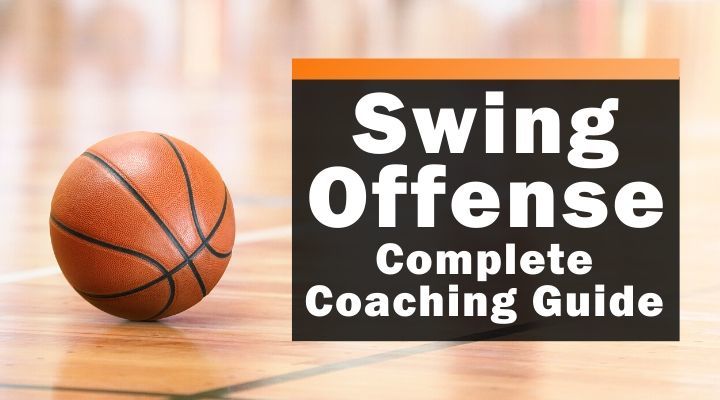
Coaches have numerous options when choosing an offense for their team.
One offense that has stood the test of time at the high school and college level is the “Swing Offense,” created by former Wisconsin head coach Bo Ryan.
The Swing is a continuity offense that repeats its pattern on each side of the floor.
It utilizes spacing, cutting, and screening to get the ball inside and to make the defense defend multiple hard-to-guard actions.
Ryan combined elements of several other offenses to create an attack that helped his team consistently be near the top of the country in offensive efficiency.
If you are looking to choose an offense for your team, the Swing certainly deserves consideration.
Who Should Use the Swing Offense:
The Swing offense is great for teams with versatile players.
All players get to showcase their skills on the perimeter and in the post as there are no defined positions.
Coaches who like the inside game should consider this offense. While there are certainly opportunities for open 3-point shots, the basis of the Swing is getting the ball in the paint.
Also, it can easily be learned by high school players, and most likely junior high players as well.
It may be difficult for youth players with limited practice time. In this case, a true motion offense (like the 5-out motion) may be preferable.
Swing Offense Strengths:
Inside Shots - The primary strength of the offense is its ability to create inside shots. When run correctly, all players will get chances to finish layups and short shots from the post.
More Free Throws - An important side effect of all of those inside shots is additional free throw attempts. The paint is where most fouls occur, and this offense wants to get the ball to the paint.
Difficult to Defend - It forces the defense to guard consecutive actions. Coach Chuck Daly once said, “The defense can’t guard two things in a row.” The Swing uses this principle, as defenders must get through multiple screens each possession.
Opens the Baseline - Because all four perimeter players play at the foul line extended or above, the baseline is open for driving opportunities.
Great for Big Guards - It is a great offense for maximizing the skills of big guards. Many opposing guards may not be adept at guarding the post. The Swing lets your guards play with their back to the basket and attack potential mismatches.
Teaches the Entire Game - It is a good skill development offense because all players play inside and out. It can be fun teaching your guards post moves and your bigs how to come off screens. This can lead to better development for all players.
Swing Offense Weaknesses:
Requires Patience - This is not a quick-hitting offense. It will eventually create a quality shot, but it may not be until the third or fourth side of the floor. If you are a coach who prefers an up and down pace with fast possessions, the Swing probably isn’t for you.
Must Have Bigs With Skill - All players must be able to handle the ball. This isn’t necessarily a weakness, but if you have a traditional center who is unskilled on the perimeter, understand that the Swing requires him or her to play both inside and outside.
Equal Opportunity - Because all players play all positions and execute the same actions, the Swing is an equal opportunity offense. This means role-definition is important. Players must know what shots are good for them and which looks the offense should be hunting.
Patterned Offense - Like all continuity offenses, the Swing is patterned. This means that it can sometimes be disrupted by pressure and a quality scouting report. Be sure to teach your players pressure release options for when this happens.
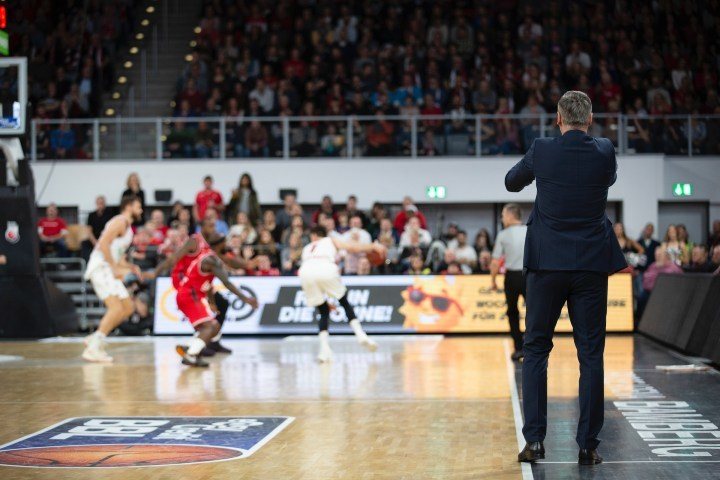
Primary Actions:
1. UCLA screens
2. Flex screens
3. Flare screens
4. Weak side exchanges
5. Post-ups
Rules:
1. Offensive players fill the following spots: Two slots, two wings, and a low post.
2. Wings must V-cut to get open to receive the ball.
3. A slot to wing pass triggers a UCLA screen from the player in the low post. The cutter now plays in the low post.
4. When the ball is on a wing, the two weak side players exchange. This keeps the defense moving, manipulating help defenders.
5. When the ball is in a slot, the weak side wing flare screens for the slot.
6. A slot to slot pass triggers a Flex screen from the low post to the wing.
How to Run the Swing Offense:
The diagrams below show the ideal spacing for the Swing.
Players 1 and 4 occupy the slots, 2 and 3 are on the wings, and 5 is in the low post.
The offense can be initiated with a pass to the slot or the wing. In this example, the first pass goes to the wing. Notice how Player 2 V-cuts to get open to receive the pass.
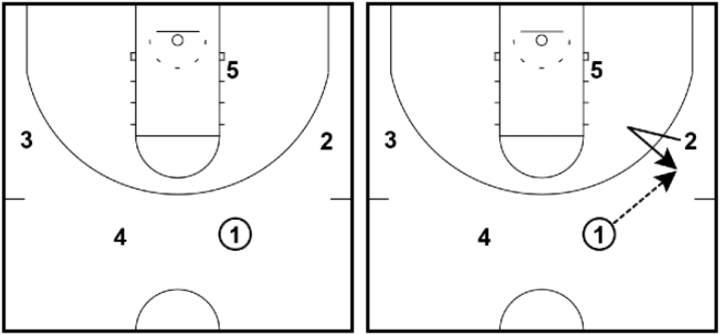
The pass to the wing means two things should happen:
(1) The post sets a UCLA screen to send 1 into the post. This is a great way to attack a size mismatch inside. After screening, 5 will step out and look for the ball.
(2) The weak side players (3 and 4) exchange by cutting to the elbow and trading spots. This keeps the help-side defense occupied.
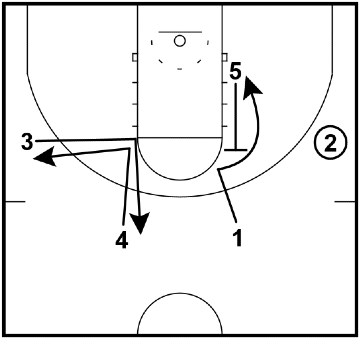
When 5 receives a pass, this triggers a flare screen from 4 to 3.
It’s important for 3 to walk the defender down to the level of the screen.
If 3 is open for a shot or a driving opportunity, 5 can make a skip pass.
Otherwise, 4 steps out to receive a reversal pass.
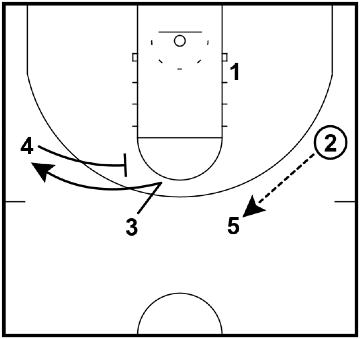
A pass from slot to slot triggers a Flex screen from the low post (1) to the wing (2).
1 and 2 must work together to ensure a good screen can be set.
If 2 is open on the Flex cut, 4 can pass for a layup.
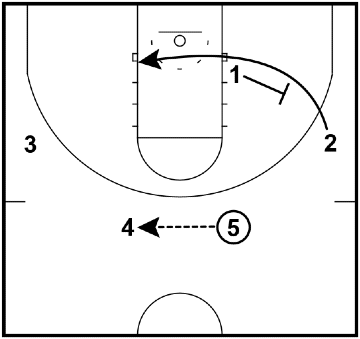
3 now V-cuts to get open and immediately looks into the post.
From here, the action starts over.
A pass to the wing results in a UCLA screen and a weak side exchange.
This offense is most dangerous once the ball has been reversed a few times because the defense now has to guard multiple actions.
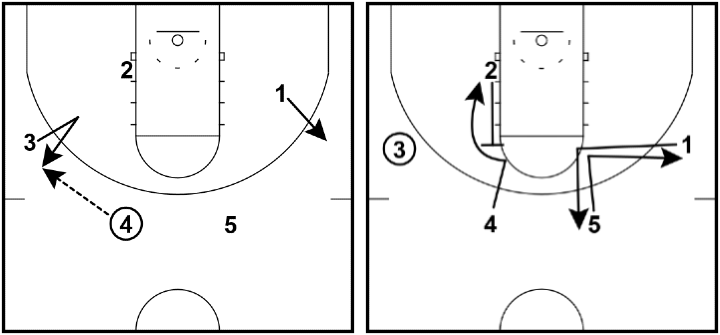
Because the objective of the Swing is to get the ball into the post, players must know what to do when a post entry pass is made.
Coaches have the freedom to implement their own post entry rules into this offense.
The first diagram below shows the weak side slot player diving to the opposite block.
The second diagram shows the passer making a “Laker Cut” to the opposite block.
There are many options, but they must be memorized and rehearsed during practice to eliminate indecision.
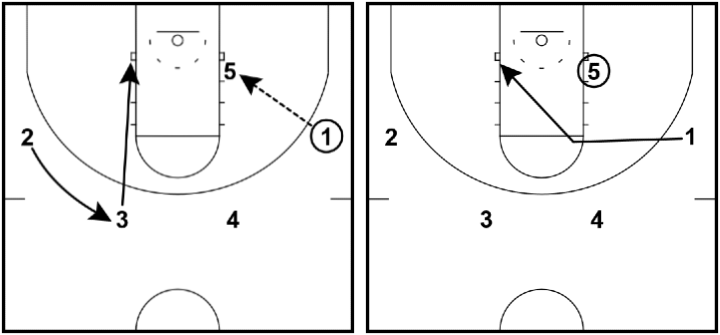
Another way of getting the ball inside is by using a top-down post entry
If this look is available, it’s preferable because the defense can give less help when the ball is on top.
When the ball is on a wing, many teams will front the post or play on the high side of the post player. So when the ball is reversed back to the slot, the post player can spin or “leg whip” the defender, keeping him on his back and clearing space for a post entry pass.
Keep in mind, guards who can execute this move will have a distinct advantage on the block because few guards are used to defending this area consistently.
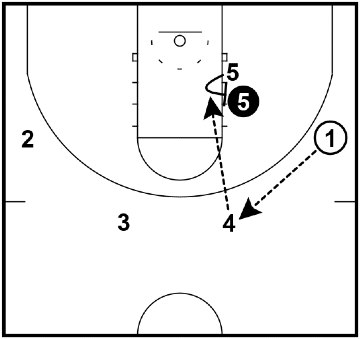
Because the offense features four players above the foul line, good drivers will often have room to attack the baseline.
When a baseline drive occurs, the post player must “I Cut” up the lane. This clears space for the driver and makes the post player available for a potential pass.
The weak side player sinks to the baseline for a drift pass.
The closest slot player gets behind the drive, and serves as a safety.
These dribble reactions must be practiced regularly.
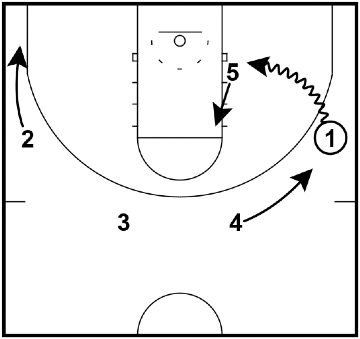
Teams will likely try to deny passes to break the pattern of the Swing.
There are several possible pressure release options your team can utilize.
The first diagram below shows an option for when the defense denies the wing. The post player (Player 5) can simply step out to back screen the denying defender. Player 5 can then step out for an easier wing entry.
The second diagram shows an option if the defense denies the slot pass. By dribbling at the slot player (Player 4), Player 1 triggers a shallow cut. This is handled just like a slot to slot pass, meaning the post should set a Flex screen.
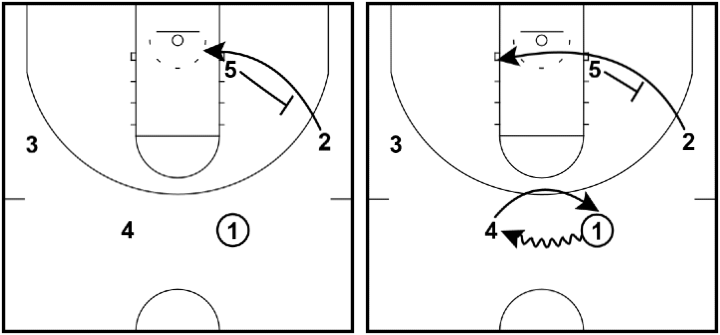
Conclusion:
If you are looking for a patient offense that will utilize each of your players, get the ball inside, and help your team get to the free throw line, the Swing Offense could be an excellent choice.
This offense lets versatile players develop their skills and score from all over the floor.
Improve your team’s offensive efficiency by implementing the Swing!
